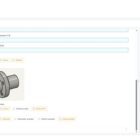In the world of machinery manufacturing, the pursuit of efficiency is a constant journey. As industries evolve and demands for innovation grow, companies seek ways to streamline their processes without compromising quality. This is where Design Automation, a key facet of Scandinavian Digital’s expertise, comes into play. In the complex world of machinery design, every component plays a crucial role. However, the diversity of products and the complexities involved in customization often lead to challenges in maintaining efficiency. The solution lies in finding a delicate balance between customization and standardization.
Standardization forms the backbone of efficiency in machinery design.
For almost 20 years, the Scandinavian Digital Team has specialized in Design Automation, working closely with machinery manufacturers. Our focus is on empowering manufacturers to use a range of tools that make the most of standardization in conjunction with modularization and parametrization. By establishing predefined components and configurations, we help reduce design time, minimize errors, and enhance overall product quality. Our expertise lies in using a set of tools that combine standard practices with flexible methods, simplifying processes to create innovative designs that automate and improve manufacturing for our clients.

Design Automation is a Catalyst for Efficiency.
It is an understatement to mention that. At the core of Scandinavian Digital’s approach is the integration of Design Automation tools. These tools allow for the creation of parametric designs, enabling quick customization based on specific requirements. By leveraging automation, manufacturers can seamlessly transition from standardized designs to tailored solutions, ensuring a perfect balance between efficiency and customization.
It is also possible to streamline processes with Configuration Management. One of the key pillars of Scandinavian Digital’s Design Automation strategy is robust configuration management. This involves creating a centralized repository of standardized components, rules, and specifications that we call Product Master Model. This repository becomes a dynamic resource that facilitates rapid design changes and updates. As a result, manufacturers can respond swiftly to market demands, adapt to new regulations, and implement design improvements without causing disruptions in the production pipeline and without having to rely on the human brain or a specific employee, which helps companies since staff turnover occurs over the years.
The importance of optimizing resources.
A lot has been said about efficiency, although in machinery design, it is not solely about speeding up the process but also optimizing resources. Scandinavian Digital understands the importance of resource management in manufacturing. Through Design Automation, we empower manufacturers to utilize their resources wisely, ensuring that every component aligns with standardized specifications. This is made possible through correct sizing and document management, such as updated and well-specified Bill of Materials and 2D drawings. This comprehensive approach leads to a reduction in waste, minimized production costs, and an overall improvement in resource utilization.
We are always looking ahead, and the Future of Design Automation in Machinery Manufacturing is a key piece. As a queen on the chess board. Scandinavian Digital’s commitment to pushing the boundaries of innovation in Design Automation positions us as a driving force in shaping the future of efficient machinery design. In conclusion, achieving efficiency through standardization is not just a goal; it’s a necessity in today’s dynamic manufacturing landscape. Standardization in machinery manufacturing offers a range of significant benefits that contribute to efficiency, quality, and overall operational success that is the main goal, we can mention interchangeability, cost reduction, faster customization, and an overall higher product quality.
As highlighted in the title of the article, Scandinavian Digital, with its expertise in Design Automation, not only aids companies in achieving the ideal equilibrium between customization and standardization but also employs its proficiency to guide them toward a future where success in machinery design is intrinsically tied to efficiency.




